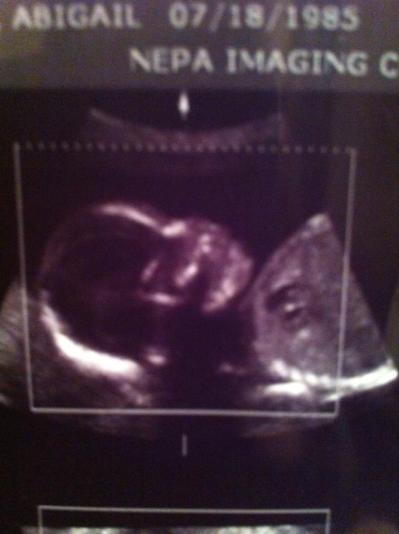My husband and I had our dear firstborn son back in October of 2010. We wanted for him to have a sibling relatively close in age, so we put it in our minds that we would like to have a baby sometime before he was three or so. A summer baby was appealing to both of us since Tim teaches middle school and would have a couple of months off available for “baby mooning.” So last fall we began trying for baby #2, and sure enough, we had a positive pregnancy test at the beginning of October 2012. My estimated due date was June 15th, 2013.
When I was first pregnant with J, we spent a long time researching our birth options and had decided on a home birth. Since we had such a lovely experience the first time, we planned on birthing our second at home as well. A brief period of financial uncertainty lead us to consider a hospital birth (since insurance would cover it), but a good tax return enabled us to pay our midwife in full and continue on with the home birth plans.
The pregnancy was quite different from J’s. I was sicker at the beginning, more emotional throughout, and faced more general pregnancy-related physical challenges. I knew that both the baby and I were healthy, and that this was a blessing I should never take for granted. The most disturbing emotion was a strange unsettledness that I was having a hard time shaking. I was worried about the “what-ifs” of labor, the concerns of mothering two children and loving them both well, the fear of returning late-onset postpartum depression, mild though it may have been.
I pushed off the feelings for a long time, believing in a way it was better not to pay them much attention. But they continued to resurface, sometimes overwhelmingly. In one way, I wanted to fast forward to the birth in order to just get it done with. In another way, I dreaded its coming since I was so nervous about my own mothering abilities.
I realized that I was neglecting to address my fears, and more importantly, I was not taking them up in prayer. I knew it was necessary for me to take time to do this. “Be anxious for nothing, but in everything by prayer and supplication, with thanksgiving make your requests known to God; and the peace of God, which surpasses all understanding, will guard your hearts and minds through Christ Jesus.” (Philippians 4:6-7) As long as I hung onto my fears, I was not entrusting them to the One who authors life and who could give me the peace I so longed for.
As I approached birth, I was reminded that it did not do me any good to worry. I needed to “seek first the kingdom of God and His righteousness,” and know that He would provide exactly what I needed (Matthew 6:25-34). I began voicing my worries to some women I trusted. Looking my fears in the face and talking them through brought both tears and great relief. I knew I was surrounded by prayer, faithful and supportive family and friends, and a skillful and compassionate birth team. All I had to do now was to rest in God’s sovereign hand and prayerfully await the onset of labor.
And wait and rest I did. The last few weeks of pregnancy was filled with more peace than I had experienced the whole time. I didn’t think that the challenges or fears would never actualize, but I knew that God would give me the grace I needed to handle each moment as it came. I took lengthy hot baths, read good birth stories and long passages of Scripture, and practiced breathing and releasing all my muscles. I drank pregnancy tea and ate dates, did the birth ball hula, and practiced squatting and kegels. I tried to mentally remember what crowning felt like and welcome it. I spent one on one time with my son and reminded myself that no matter how difficult mothering can be, the joy of knowing and loving each sweet soul was immensely worth every second of it. And as my due date approached, I finally felt ready.
During these last two or three weeks, I experienced light crampy contractions that would last for an hour or two here and there and then stop. I recognized all the usual pre-labor signs- diarrhea, loss of large hunks of mucus, and just feeling “off.” But the signs never went anywhere. I tried checking my own cervix, and it did seem that there was some softening and dilation occurring. As days went on, I could no longer find a distinct ring of cervix, so I decided that I didn’t really know what I was feeling and I probably was just feeling the vaginal wall. The day before my next appointment, I felt a lot of extra pressure in my bottom and assumed it was the baby “dropping.” I told myself not to get hopeful, and that I couldn’t possibly be significantly dilated. Better to expect nothing than think I had made progress, right?
On June 13th, 39 weeks and 5 days, my midwife, Jen, came to my house for our regular 10:30 am appointment. (Coincidentally, it was also Jen’s birthday.) We had discussed all of my “pre-labor” and she thought it would be prudent to perform an internal exam to see what was happening. Since she lived about an hour away, she was concerned about the possibility of a precipitous labor if I was already considerably dilated. After discussing our options, Tim and I decided that if we were pleasantly surprised by my progress, we would go ahead and have Jen sweep my membranes and see if we could get labor going while she was in the area.
As Jen was checking my cervix, she got a funny smile on her face and said, “Hmm! You’re about 60% effaced… and 5 cm dilated this way… and 4 and a half the other way…”
Five centimeters and not in labor?!? I just started laughing. Tim and I were in disbelief that I was already so far progressed! My son’s labor had been so “textbook,” so slow and steady, that I never thought I would end up dilating without any significant pain or long early labor. We also learned that the baby’s head was already at +1 or +2 station, so he or she was already coming into the birth canal. (Aha. That explained all that extra pressure.)
We agreed to have Jen sweep my membranes (a rather uncomfortable procedure, though not painful), and also decided to try some herbal augmentation to see if things would get going while she was still in the area. She left me some “labor prep” herbal pills and a black & blue cohosh tincture mixed into my morning’s green smoothie. Off she went to some other appointments close to our home, leaving instructions to call her if I began contracting hard at any point. She would come back to check on me in a few hours.
Within 30 minutes of our appointment’s end- about 12:00 noon- I did begin experiencing some contractions. While they were more powerful than my Braxton Hicks, they were no more painful and were not accompanied by any cramps. They felt like strong waves of pressure that took my breath away, though I could still walk and talk through them. They developed into a pattern, coming about 3-5 minutes apart, but only lasting about 30-45 seconds long. I decided to eat a small but nourishing lunch for energy in case this turned into the “real deal.”
Jen called to check on me, but I told her that the contractions were nothing to write home about. She laughed because that was what I had been saying before- and I was obviously already dilated despite the fact that I wasn’t in pain. She said she would still come after her last appointment for the day.
Around 2:30, Jen arrived. My contractions had not progressed to be any longer or stronger. She observed me for a little while and suggested taking more of the tinctures. She said she would hang out at our house for a while because she “didn’t trust me.” She joked that as soon as she turned around and drove home, she knew I would be calling her in hard labor. Thus, even though we are all of the mindset that we would rather wait for labor to pick up on its own, we decided, given the circumstances, that it was still the wisest course of action to try to give it a little boost. (Plus I wasn’t really worried about any negative side effects of the herbal tinctures like I would be about Pitocin and other drug use.)
Since it was Jen’s birthday (and since J had gone down for his nap), I decided to bake a cake while we waited around for this labor thing to get painful. Too bad I didn’t have any white sugar… or powdered sugar… or cake mix… or frosting. I found a yellow cake recipe that I thought I could make successfully with raw sugar, so I put it together and stuck it in the oven. I searched the internet for a frosting recipe that used honey instead of sugar. We found one, but it turned out to be quite nasty as it called for a large amount of non-fat dry milk. We all laughed at my dismal frosting failure, and Jen suggested she run me to the store for frosting and sugar so that we could consume a palatable birthday cake. (Plus all that going up and down the store aisles might help progress the labor!)
I had to smile as we were going to the grocery store. I thought to myself, How cool is this? Most women’s care providers don’t even know their names without looking at their charts first, and here I am having a relaxing afternoon with my midwife, running errands while I’m in light labor. We selected our items and had a memorable checkout experience with an awkward cashier. (Let’s just say that there was story telling about an internet figure who drinks bottles of Pert shampoo and other household products.) After some laughs, we headed back home.
I was still having the contractions, but I barely noticed them now. I was beginning to feel doubtful that I was really in labor. I felt a little anxious about what we would do if it all stalled out. We decided we would frost and eat Jen’s birthday cake, and then she would check my cervix again.
One slice of cake later, at 5:30 p.m., I was lying on the bed expecting to hear that there had been no changes. Once again, Jen laughed as she performed the exam. “You’re about 80% effaced and 7 cm. Abi, I can stretch you to an 8!”
Eight centimeters and no pain to speak of? I never thought I’d be one of those women- the ladies who I thought of as the lucky ones!
The fact that I had dilated this far with very mild contractions was actually a bit of a concern for us. We knew I would need good strong contractions to help push that baby out- but also to help my uterus clamp down after birth to prevent hemorrhage. (I had experienced significant blood loss after the birth of my son. While it had never gotten out of control, we wanted to avoid a repeat if at all possible.) I agreed to homeopathic pills inserted vaginally to see if that would help move contractions along.
J woke up from his afternoon nap shortly after the exam. We called my sister-in-law, Michelle, and our birth photographer, Emily, to let them know what was happening and tell them they should come in case things moved quickly.
Within a half hour of the homeopathy, I began getting contractions that felt more “real.” They still seemed like early labor. I could talk through them easily, but at least they were mildly uncomfortable. Tim inflated the birth pool and began filling it; I put my pre-made freezer meal into the oven to heat up. Michelle arrived to help watch J, and Tim and I got ready to go for a walk to help progress the labor.
It had been raining on and off all day, and sure enough, it began coming down harder once Tim and I went outside. No matter. I put up my hood, took Tim’s hand, and we began a brisk walk in the cool, wet evening. We remarked that this must be our labor tradition, as we had gone for a walk in the rain through transition during J’s labor as well. As we walked, we began humming and singing children’s folk songs during contractions. I knew that opening the mouth and throat through contractions helped to relax the mother and open the cervix. It seemed to be true- it made the contractions seem more manageable- much like strong pressure waves. I also helped myself through it by acting silly- I went on melodramatically about my cervix opening up like a flower to the sun and softening in the cool rain. Being ridiculous helped me to laugh and stay positive through the intensity of contractions. I think the fast walking also served as a welcome distraction. All of these were my pain management tools as we walked about a half a mile along our road under the trees.
The walk was definitely effective in helping contractions become stronger. During the twenty minutes or so that we were gone, I felt like I went from early labor to transition type contractions. As we neared our return, I could feel the baby pushing down lower. I told Tim that we had to get back quickly, or I would end up having the baby on the side of the road!
We returned to a welcoming house full of warmth and light and cheerful activity. Jen had prepared for the birth by pulling out supplies and monitoring the tub’s filling. Michelle had pulled the dinner out of the oven. Emily had arrived and was ready with her camera. Michelle was surprised by how much stronger my contractions were, and Jen asked me when I wanted to get into the pool. I replied that I was ready when the tub was.
Jen had a quick listen to the baby, and then I went to use the bathroom before getting in the pool. As soon as I sat down on the toilet, I felt that familiar pressure of the baby getting ready to be born. One heavy contraction passed. I tried to get up and another came on quickly. I attempted rising again and a third slammed me back down. I kept humming and breathing my way through them as best as I could. They were right on top of each other now, and I knew I had to make it out of the bathroom if I wanted to avoid a toilet birth.
I finally made it out of the bathroom. Jen asked me if I wanted to wear anything specific in the birth pool, and I told her yes, a sports bra and a tank top. She told me that I might want to go get that on if I wanted it. Yes, yes, I knew that, and I was trying, but I just couldn’t get a break between those contractions… Michelle offered to go get it, and I told her no- that going up the stairs would be good for me. But the stairs stopped me in my tracks again. Each step I tried to take stimulated another hard contraction, and I finally shouted at Tim to “just go!” and fetch my clothes for me.
At last, I got changed and made it into the pool. Jen asked me if it felt any better in the water, and I told her that I thought maybe it did, but I remember feeling disappointed that the water wasn’t hotter. In hindsight I recognized that of course I couldn’t birth a baby into Jacuzzi water temperatures, but it was still a let-down.
At this point the labor became a bit of an out-of-body experience. I kept humming with Tim through each contraction, but I knew that I would have to push soon. I thought to myself, this is why women get epidurals. Can I just wake up when it’s over? It wasn’t so much the pain that was overwhelming as the sheer intensity of it all. My hum turned into a low moan as I felt the baby begin to descend into the birth canal. Before the next contraction began I quickly told Tim, “no more song.” He said, “Okay,” and sat faithfully at the side of the pool by my head. J came in and out of the room a couple of times, wanting to show me a paper butterfly from his bug book. He seemed generally unfazed by my strange behavior, as we had prepared him in advance for the sights and sounds that accompany hard labor. I asked if we had towels for the baby once it was born. Yes, Jen had already done that. I asked if they had a garbage can for me in case I puked. No, but Tim scurried upstairs to fetch one. The doula in me was going through a mental checklist of necessities.
Now I had to keep a low moan sustained through each contraction. “I’mmmmmm gonna puuuuuuuush….” I groaned as I heard myself making those familiar grunty sounds.
“Okay, go ahead,” said Jen. And everyone attended me patiently and quietly.
Oh, what a simultaneously glorious and dreadful feeling it is to push a baby out! There’s nothing quite as satisfying, because you know that you’re almost done and you’ll get to meet your precious new life very soon. But there’s also nothing quite as terrifying because you know there’s just no way around it. You don’t want to do it because you know it’s going to hurt badly, but if you don’t just do it you’re going to remain in this pain even longer. So you have to just buckle down and sweat and grunt and moan and let it happen. With my son, I hadn’t felt an urge to push until the very end. And with this baby, I felt the urge overtaking me without my consent. It was like a freight train, like throwing up-only throwing down.
I was so conscious of everything. I could feel the baby’s descent, and I briefly thought about forcing harder to get it done with. But then I thought, no, you’ll tear. Slow down. It won’t be long. Slow down and breathe. I kept saying, “I’m sorry if I poop!” but everyone assured me that it didn’t matter if I did. (Miraculously, I didn’t.)
There was a sudden sharp pop and gush as my water broke. This was much less pleasant than I remembered it. It wasn’t long before I realized that Tim was in the pool with me. It must be close or he wouldn’t be in here yet. Jen told me gently to slow down.
“I’m trying!” I responded. Then self-doubt flooded me. “Am I doing okay? Am I doing good?” I breathed. (I mentally reminded myself that it should have been, “Am I doing well?”)
“Yes, Abi,” she affirmed me warmly. “You’re doing good.” (She didn’t correct my grammar, bless her.)
And much sooner than I expected, I felt that surreal stretch as the baby crowned- I held it there for just a moment- and oh! The head was out!
“Oh, that’s SO much better!” I exclaimed.
Jen and Tim remarked that there was a lot of hair. Suddenly there was an unexpected sharp pain.
“Whoa!” cried Jen and Tim together. “That’s a hand!” added Jen. It turns out that pain was my baby trying to “swim” its way out with a nuchal hand by its face.
And suddenly Jen was lifting me up onto my hands and knees, saying, “Okay, let’s get you out of the water.” I mentally jumped to a shoulder dystocia diagnosis, but then just as quickly as I got up out of the water the baby slid out the rest of the way. (It turns out the baby was just about to try to breathe underwater, so that’s why Jen lifted me up. Phew, no major obstetrical emergencies here!) She was born at 7:12 p.m., and I had only pushed for 12 minutes.
I was eager to see this baby, so I sat back against the pool wall as quickly as I could. Tim and Jen brought the child to my chest and covered it with a towel. I admired our new little life, stroking its hair, rubbing in the vernix, quietly saying, “Hello, baby, you’re beautiful.” Tim leaned over my shoulder and gazed into those bright blue-grey eyes and smiled.
“What is your baby, dad?” Jen asked.
We both realized that in the joy of meeting our child, we forgot to check the gender! Tim peeked up under the towel and announced that it was a girl!
She was still and calm and alert. She had only let out one little cry when she was lifted out of the water to be put on my chest. I was concerned about whether or not she was okay because she wasn’t crying, but Jen assured me that her breathing, heart rate, and color were perfect. She told us that water babies are often calm and quiet when they are born.
J came trotting in, followed by Michelle. (She had been watching him and playing with him in the living room.) He came up to Tim and the two of them shared a great big hug. We showed him his sister, and told him that the baby had come out and it was a little girl! He approached cautiously and looked at her coolly from across the pool. We didn’t force him to come closer- we figured he would do that in his own time. He seemed generally happy enough, however, and went back to playing as we continued to greet our little one.
Our baby girl began rooting, so I took off my tank top and tried to help her find the breast. She latched quickly and knew just what to do! As she was nursing, we watched for any bleeding and checked on the cord. Michelle began calling family members to share the good news.
Probably about 15- 20 minutes after birth, the cord had completely stopped pulsing. We invited J to help cut the cord (this was something we had talked about before the birth). At first he was excited- “With scissors?” he asked. Then when he saw that he had to come up close to the pool and his baby sister to use them, he said, “No thank you!” We laughed and told him he didn’t have to help, and Tim physically separated baby and mama for the first time with a snip.
Thankfully, the placenta came out with no problems, and I lost significantly less blood than I had with J! (I had lost about 900 ccs with him, and only 300 with this baby. 500 ccs is about average for a vaginal birth.) Tim took our baby girl while Jen helped me get to the shower to clean up.
Soon, our new family was snuggled on the roll-out mattress we had brought downstairs for the birth. Jen performed a full newborn exam and pronounced our little girl 8 lbs., 9 oz. and 20.5” long! She had a 14” head circumference, just like her brother. I continued nursing her skin to skin under a blanket while Jen went over postpartum information with us. Afterwards, Tim helped to dress the baby and I in comfortable pajamas. James wanted to have his little sister laid on his belly so he could hold her. He was finally smiling at her and wanting to see her- and he hasn’t stopped since! After warm hugs and thank you’s all around, Michelle, Jen, and Emily made their separate ways home.
Tim and I talked, and we confirmed our name choice for our little girl- I will call her V for the sake of privacy on the blog.
My family came shortly thereafter, and got to meet their new granddaughter- as well as help put J to bed! Unfortunately, Tim’s parents were on vacation with West coast family at the time, but they came in to meet her as soon as they arrived home a couple of days later.
As we reflected on the birth, we were amazed by how different it had been from J’s. His was a steady 14 hours of labor, but V’s was only about 8 hours total. Less than two hours of that had any pain, and only about a half hour at the end was truly difficult. I don’t entirely know why this was (though I have my theories), but I’m very thankful for the experience of an almost pain-free labor.
V has been a true joy to us. We are enjoying getting to know her little personality and learning more about her each day. I am reminded by her birth and life so far that time does go so quickly, and that it is most important to soak up every minute with your children and fill each day with love for them. Before I know it, years will fly by, and they will be grown and gone. If anything, our daughter’s life has increased my love for both her and J deeply.
I am grateful for my wonderful midwife who cared for me physically and personally during this pregnancy and birth. I am grateful for an excellent birth team who came just at the right time and was so helpful to us. I am grateful for a loving and supportive husband- I could never fulfill my role as wife and mother without his patient and gracious help. I am grateful for my two sweet children, who we love more than the world. We are so, so blessed in every way. Praise God for his gracious gifts!




 nd.
nd.






